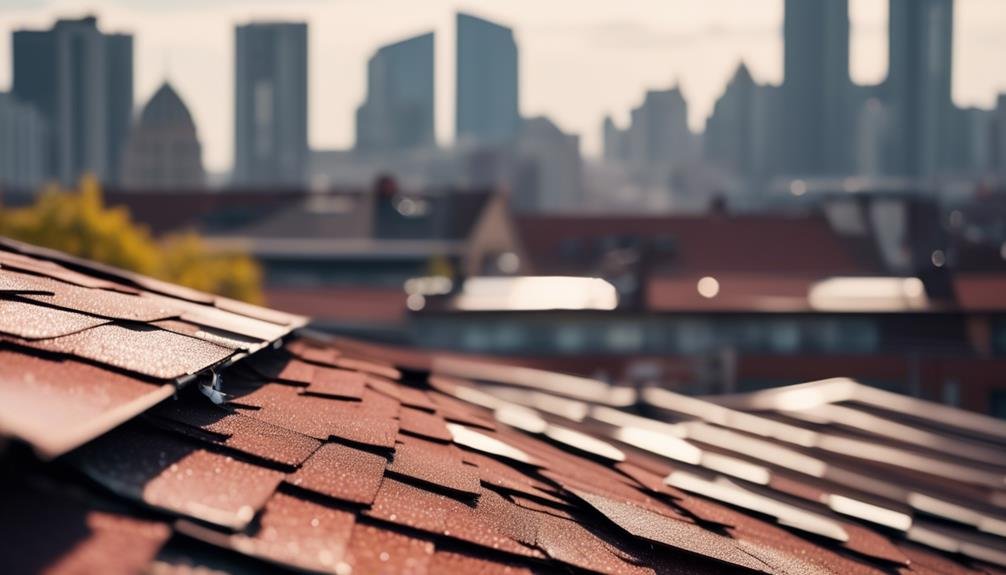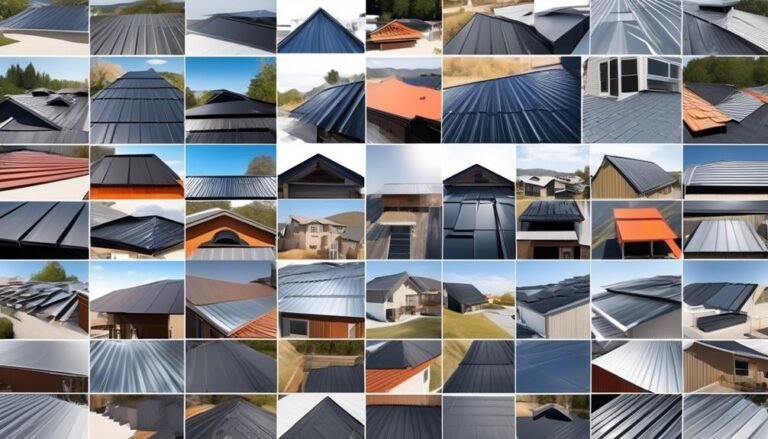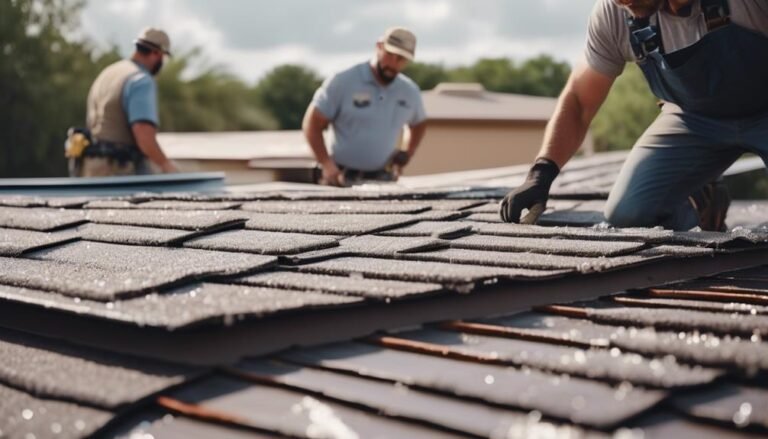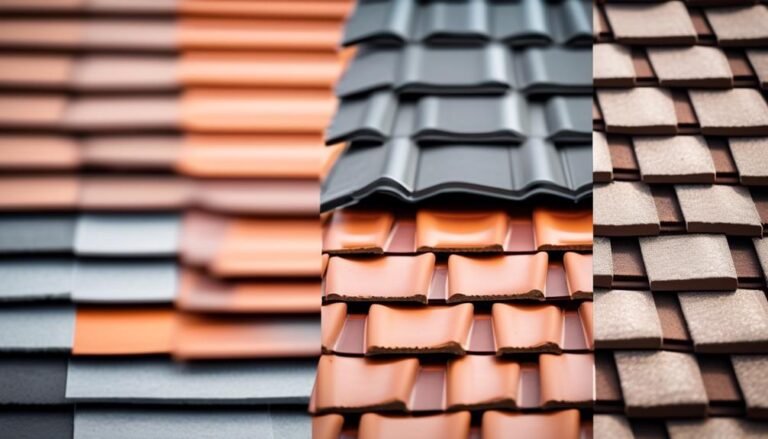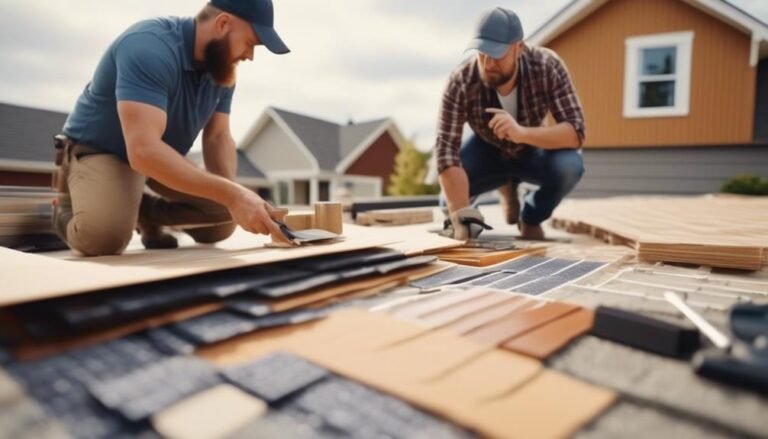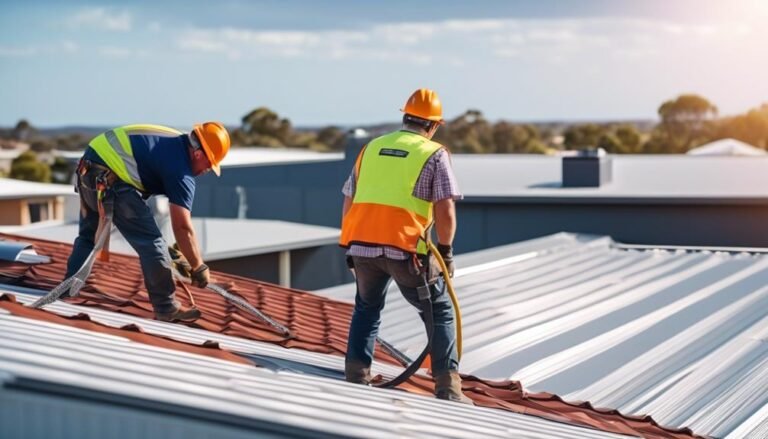14 Urgent Roof Repair Tips for Antonio Residents
If you've ever been through a severe storm in Antonio, you might have wondered how to handle urgent roof repairs. It's not always easy to know where to start or what steps to take to ensure your home remains safe and secure.
With 14 essential tips for addressing roof damage, you can equip yourself with the knowledge needed to handle emergencies effectively. From identifying the urgency of the situation to understanding material options and choosing reliable contractors, these tips will help you navigate the challenging process of roof repair.
Whether you're dealing with leaks, fallen trees, or structural issues, these tips will provide you with a roadmap for addressing urgent roof repairs in Antonio.
Key Takeaways
If you've ever experienced a severe storm in Antonio, you might have wondered how to handle urgent roof repairs. It's not always easy to know where to start or what steps to take to ensure your home remains safe and secure.
With 14 crucial tips for addressing roof damage, you can equip yourself with the knowledge needed to handle emergencies effectively. From identifying the urgency of the situation to understanding material options and choosing reliable contractors, these tips will help you navigate the challenging process of roof repair.
Whether you're dealing with leaks, fallen trees, or structural issues, these tips will provide you with a roadmap for addressing urgent roof repairs in Antonio.
Identifying the Emergency
When water starts leaking into your home after a strong storm, it's a sign of trouble that needs quick attention. Taking immediate action is crucial to stop further damage to your roof and property. Common emergencies like leaks, pests, fire damage, fallen trees, and structural collapse can all be serious threats to your property and safety.
A leaking roof, in particular, can cause a lot of damage inside your home if it's not fixed fast.
In these situations, it's important to reach out to professionals who specialize in emergency roof repairs. These experts are ready to handle urgent problems and can give you fast solutions to reduce the damage.
Assessing Safety Risks
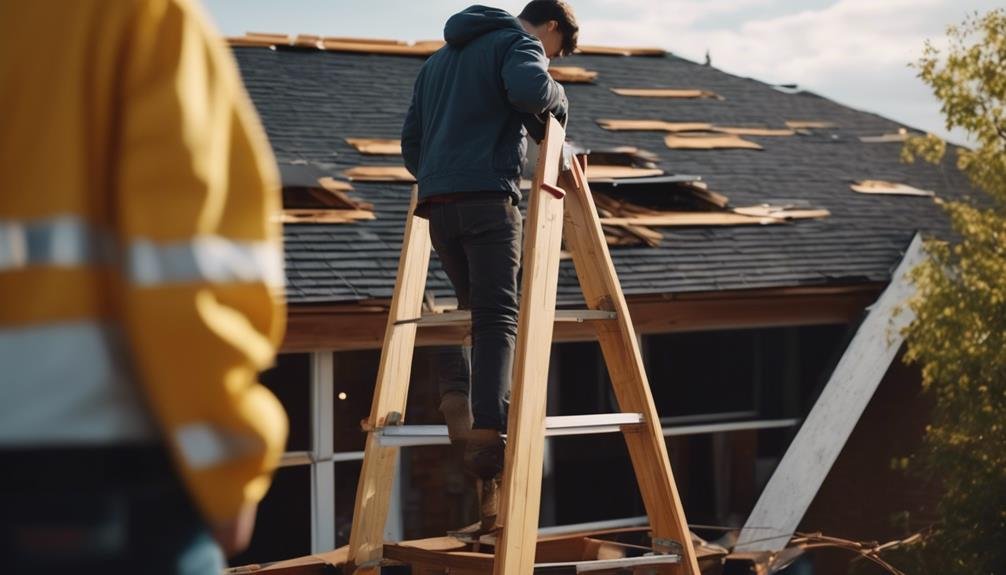
Before you start any roof repairs, it's really important to make sure everything is safe up there. Check for any loose or damaged roofing materials.
Make sure the surface you'll be working on is stable.
Watch out for any electrical hazards. By doing this safety check and taking steps to reduce any risks, you can help prevent accidents and make sure the repair process is safe for everyone involved.
Safety Inspection Checklist
Getting ready for DIY roof repairs? Start by checking for safety hazards. Here's a checklist to help you stay safe:
- Wear long sleeves, gloves, and eye protection when inspecting or working on the roof.
- Have someone hold the ladder for stability and safety.
- Don't walk on the roof until you've assessed the damage and any potential risks.
Risk Mitigation Strategies
When you need to do emergency roof repairs on your own, it's important to think about safety first. Take a good look at the risks involved before you start. Here's a simple table to help you:
| Risk | Potential Danger |
|---|---|
| Not enough safety gear | Falls and injuries |
| Unstable roof | Collapse |
| Electrical hazards | Shocks or electrocution |
Thinking about these risks can help you make smart decisions, especially after a storm. Always put your safety first and get professional help if you're not sure about doing the repairs yourself.
Documenting the Damage
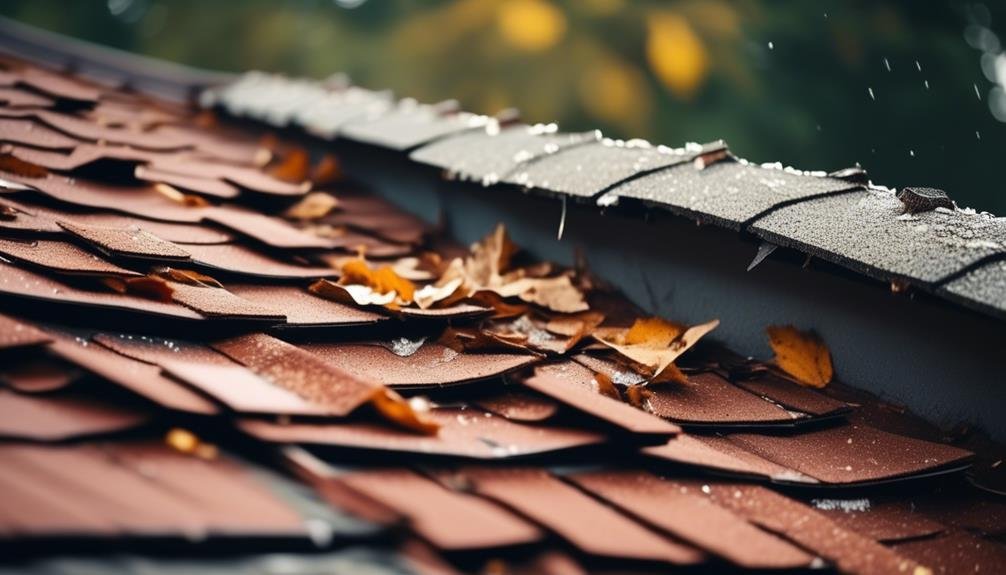
When you're taking stock of the damage to your roof, it's really important to snap some photos of any missing shingles, fallen branches, tears, cracks, and damaged gutters and flashing. These pictures, along with detailed descriptions, will beef up your insurance paperwork and back up any claims you might need to make.
This documentation will also help the roofing contractor understand just how much damage there's and figure out what repairs are needed.
Photo Evidence
Taking clear and detailed photos of the roof damage is crucial for homeowners. These photos will help you in the insurance claim process and assist the San Antonio roof repair contractor in understanding the extent of the damage. By documenting the damage thoroughly, you'll ensure that the necessary repairs are accurately assessed and addressed.
When taking photos, make sure to capture the following:
- Missing shingles
- Fallen branches, tears, cracks
- Damaged gutters
This will give you peace of mind and confidence as you proceed with the roof repair process.
Detailed Descriptions
When your roof gets damaged, it's crucial to document it thoroughly with clear photos and detailed descriptions. This documentation is important for two reasons: it serves as evidence for insurance claims, and it helps roofing contractors understand the extent of the damage.
So, when you're documenting roof damage, be sure to take notes and pictures of any missing shingles, tears, cracks, or any other visible damage. These descriptions and photos will help you when filing insurance claims, and they'll also make it easier for roofing contractors to assess the necessary repairs.
Accurate documentation is also important for property inspections and determining if temporary repairs are needed. By providing comprehensive descriptions of the damage, you can effectively communicate with the insurance company, making sure that repairs are properly assessed and covered.
Insurance Documentation
In order to make sure your insurance claim process goes smoothly, it's important to carefully document the damage to your roof. This means taking detailed photos and making notes that accurately show the extent of the damage.
Here's what you should do:
- Take clear and detailed photos of the damaged areas from different angles.
- Make notes about when the damage occurred and any relevant weather conditions at the time.
- Keep all your documentation organized and easily accessible for your insurance company and for future reference.
Clearing Debris
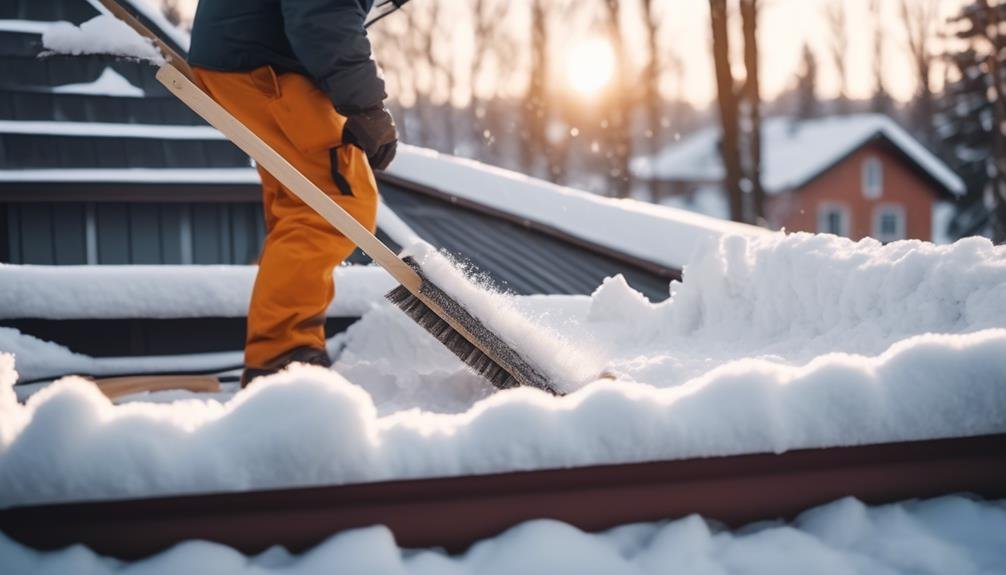
As a homeowner, it's important to regularly check your roof for fallen branches and debris. Removing these promptly is crucial to prevent damage and potential mold growth. Debris left on the roof can weaken the structure and promote mold, so it's essential to clear it to avoid further issues.
Be careful when clearing debris to avoid causing more damage to the roof. Using the right tools and being cautious can help maintain the roof's integrity and prevent future problems like leaks.
Taking the proactive step of clearing debris from your roof can help prevent damage and keep your home in good shape.
Temporary Roof Covering

When your roof has a hole, using a heavy tarp to cover it's really important. This helps stop more damage from happening.
If you have smaller holes, you can use caulk or roof cement to temporarily fix them.
It's also a good idea to put a tarp on the roof to stop leaks while you wait for proper repairs.
Tarp as Temporary Cover
When you have large holes in your roof, using a weighted roofing tarp as a temporary solution can help prevent further damage. Here are some tips for using a tarp as a temporary cover for your damaged roof:
- Secure the Tarp: Use furring strips or 2x4s to tightly fasten the tarp to the roof, so it doesn't get lifted by the wind.
- Overlap Seams: When laying down the tarp, make sure to overlap the seams by at least 6 inches to stop water from seeping through the gaps.
- Check Regularly: Keep an eye on the tarp for any signs of lifting, tearing, or water accumulation. Make adjustments as needed to keep it effective as a temporary protection.
Securing Temporary Patches
Securing temporary patches for your damaged roof is crucial to prevent further damage and water leaks in your home. Here's a simple guide to help you secure temporary patches effectively:
Materials Needed:
- Heavy-duty roofing nails or screws
- Hammer or screw gun
- Roofing cement or sealant
Steps to Secure Temporary Patches:
- Place the patch over the damaged area.
- Secure the patch by driving the nails or screws through the patch and into the roof deck.
- Apply roofing cement or sealant around the edges of the patch for added protection against leaks.
Using heavy-duty roofing nails or screws will firmly attach the patches and prevent them from being dislodged by strong winds or other weather conditions. This will help minimize the risk of further roof damage and water damage to your home.
Weatherproofing Vulnerable Areas
When it comes to protecting your home from potential damage, it's crucial to take immediate action. Start by using a weighted roofing tarp to cover any large holes in your roof. This will help prevent water from getting inside and causing further problems.
Next, focus on filling smaller holes with caulk or roof cement. This will create a temporary barrier against the elements and buy you some time until permanent repairs can be made.
If you notice that only a few shingles are damaged, consider replacing them to keep your roof in good shape.
Monitoring for Leaks

Keep an eye on your roof regularly to catch any potential leaks and prevent damage. It's important to stay on top of it and take care of any issues as soon as they pop up.
If you notice any signs of damage on your roof, find the source of the leak and put a container to catch the water. Take a good look at the leak and figure out what's causing it.
For small problems like cracked or missing shingles, you might be able to fix it yourself. But if you're not comfortable or if the damage is serious, it's best to call a roofing professional. They've the skills and tools to figure out and repair the damage to your roof.
Gutter Maintenance
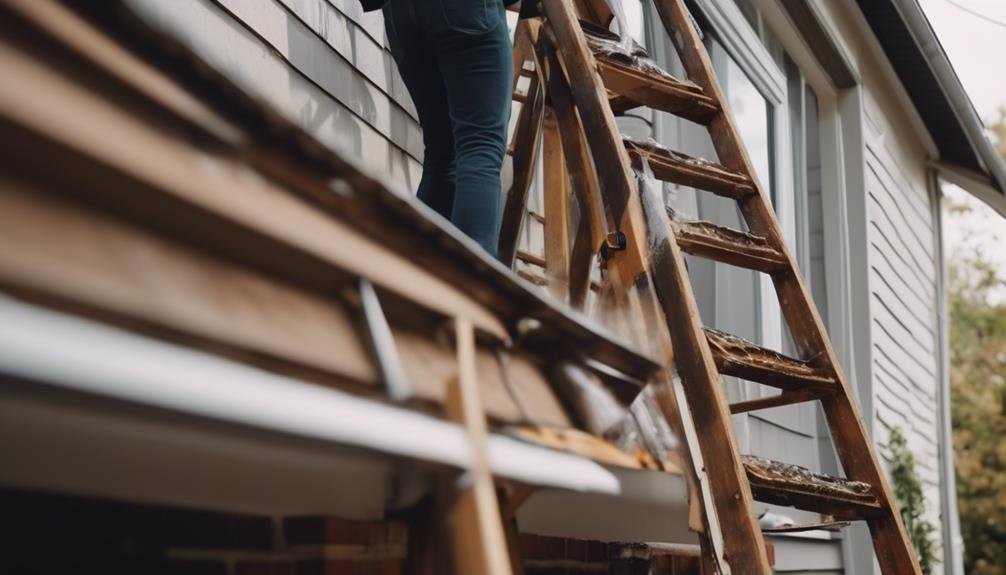
Hey homeowners, don't forget to maintain your gutters!
It's important to regularly clear out any debris and check for clogs to make sure water can flow properly. This will help prevent damage to your roof and stop any potential leaks from water buildup.
Also, be sure to check that your gutters are securely attached and free from damage so they can do their job effectively.
You might even want to think about installing gutter guards to reduce the need for regular maintenance.
Clearing Debris Regularly
Regularly checking and clearing your gutters and downspouts is crucial for protecting your roof from potential water damage. It's important to maintain your roof's integrity and prevent costly repairs.
Here are three essential tips for clearing debris from your gutters:
- Schedule Regular Checks: Make it a habit to inspect your gutters for debris at least twice a year, especially after heavy storms or wind. Look for signs of clogs, like water overflowing or pooling near the foundation of your home.
- Remove Debris Promptly: When clearing debris, be sure to remove all leaves, twigs, and other obstructions from the gutters and downspouts to ensure proper drainage and prevent water damage.
- Check for Missing Shingles: While clearing debris, take the opportunity to check for any missing or damaged shingles on your roof. Addressing these issues promptly can prevent water leaks and further roof damage.
Regularly clearing debris from your gutters is essential for maintaining a healthy roof and preventing potential water damage.
Checking for Clogs
When you take care of your gutters, it's important to regularly check for clogs and debris. This helps prevent water damage to your roof. Make sure to inspect your gutters and downspouts for any leaves, twigs, or other debris that could block the flow of water. Clear out any clutter right away to stop water from collecting on your roof, which can cause damage and leaks.
Seeking Professional Help
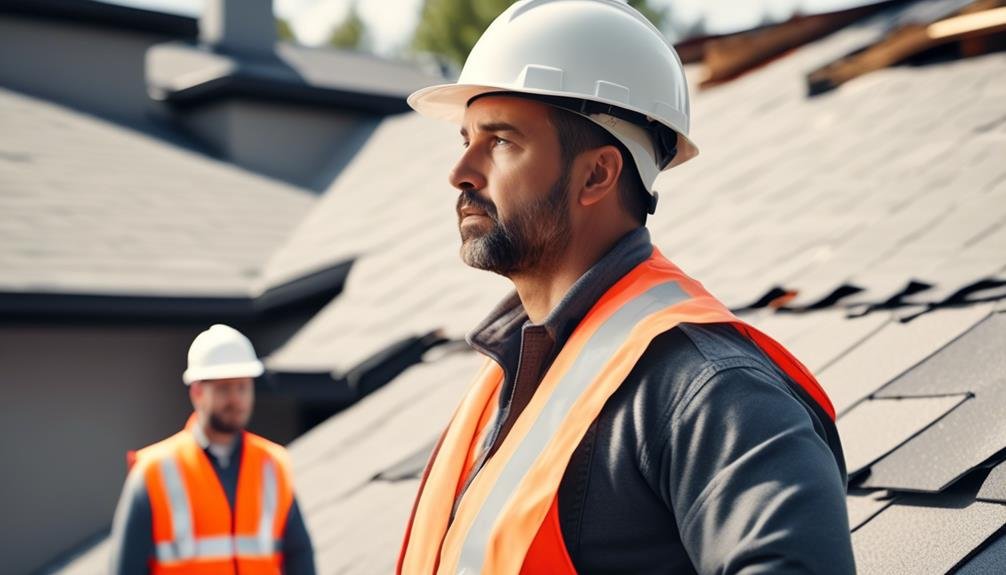
If your roof has extensive damage, it's important to get professional help from a reputable roofer. Here's why it's crucial:
- Expertise: Professional roofers have the knowledge and experience to accurately assess the extent of roof damage and recommend the most effective repair solutions.
- Safety: Roof repairs can be dangerous, especially for extensive damage. Professionals are equipped with the necessary safety gear and training to handle repairs without putting themselves or your property at risk.
- Long-term Benefits: Hiring a professional ensures that the repairs are done to a high standard, reducing the likelihood of future issues and potentially saving you money in the long run.
Insurance Claim Preparation

When dealing with an insurance claim for your roof, it's important to have thorough documentation and insights from the professional roofer's assessment. Take detailed pictures and notes of the roof damage, as these will be crucial for supporting your insurance claim.
The visuals and notes won't only help the roofing contractor understand the extent of the damage but also assist your insurance company during their assessment.
Contact your insurance company to determine the coverage for the roof repair and to understand the process for filing a claim. Documenting the damage thoroughly and accurately is key, as this will significantly support your insurance claim.
When the insurance company conducts their inspection, it's beneficial to be present and assist in the assessment, providing them with the gathered documentation and insights.
Preventing Further Damage
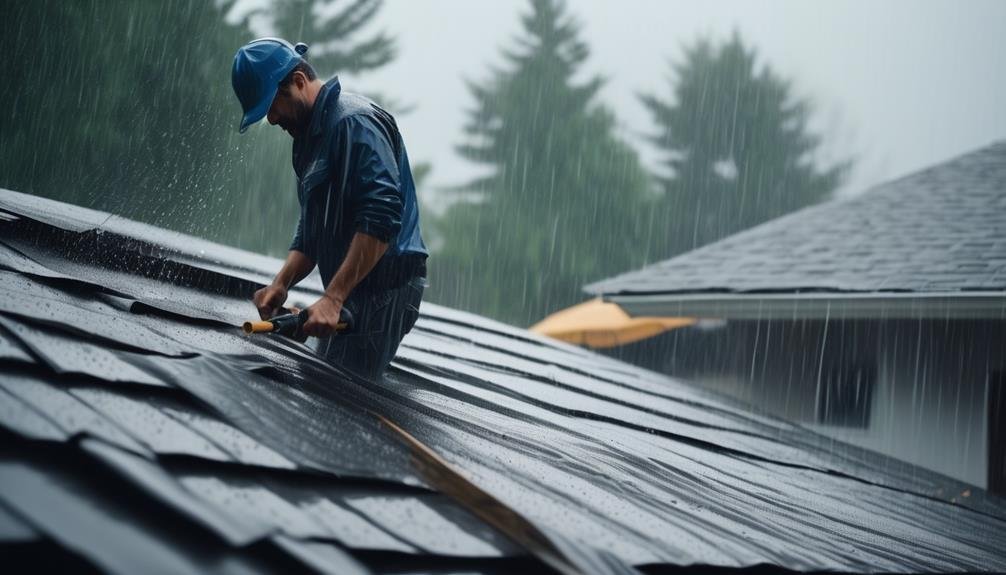
As a homeowner, it's crucial to take quick action to prevent further damage to your roof. This includes addressing issues such as leaks, pests, fire damage, fallen trees, and structural collapse. Here are some steps to help you protect your home:
- Find where the leak is coming from and place a container to catch the water. Check for cracked or missing shingles and consider fixing them yourself. If the damage is extensive or if you're not comfortable doing repairs, it's best to call a professional to prevent more damage.
- Regularly check your roof for any issues to stop leaks and damage from getting worse. Use temporary fixes like weighted roofing tarps and filling small holes with caulk or roof cement to prevent further damage.
- Stay ahead of roof maintenance. Trim tree branches hanging over your roof to prevent damage from fallen trees. Make sure your attic and roof have good ventilation to prevent fire damage and reduce the risk of pests.
Understanding Material Options
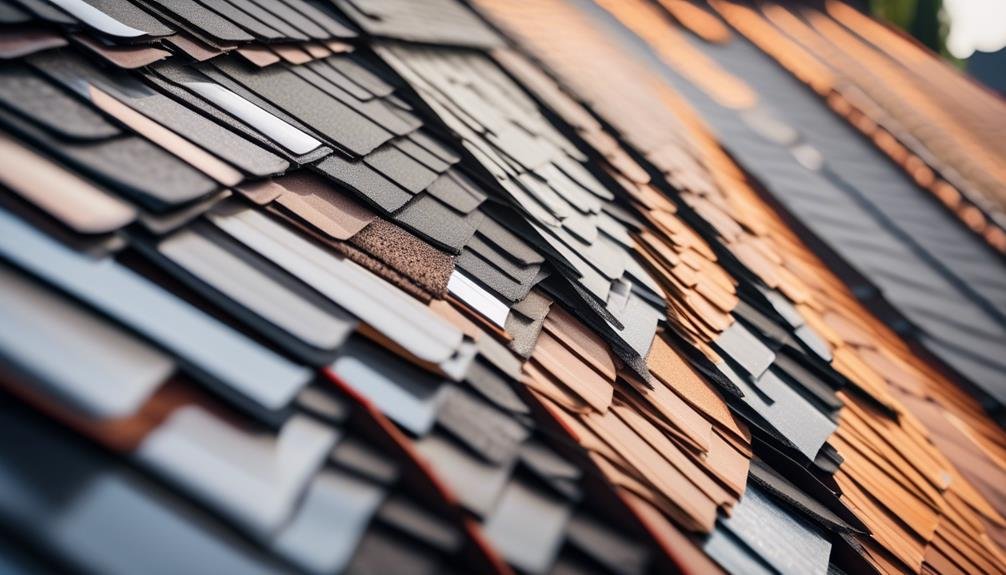
When you're thinking about materials for your roof, it's really important to do some research and understand the different options available. Different materials have different lifespans, maintenance needs, and costs.
For example, asphalt shingles are popular because they're affordable and easy to install, while metal roofing is super durable and energy-efficient. Clay or concrete tiles have a classic look and last a long time, but they can be heavy and might need extra support for your roof. Wood shakes give a natural, rustic feel but need regular upkeep. Slate is really durable and looks elegant, but it can be pricier.
Every material has its own pros and cons, so it's key to pick one that fits your style and budget. It can be really helpful to get a pro to check out your roof for free and give you advice on the best material based on your needs and the damage to your roof.
Choose a material that not only looks good on your home but also keeps it safe and sound for a long time.
Long-Term Repair Planning
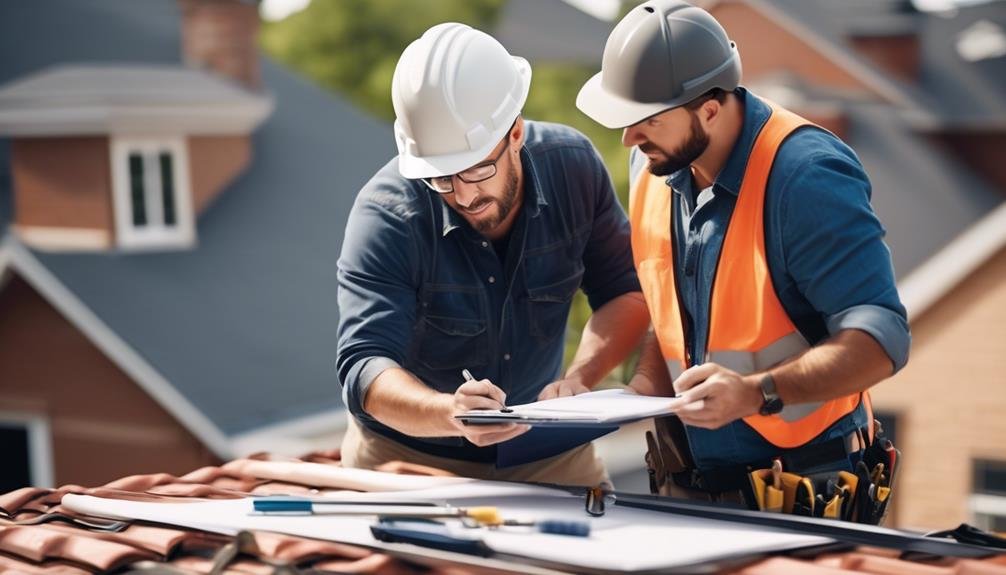
When thinking about repairing and maintaining your roof, it's important to consider the long-term needs of your home. Factors like the age of your roof, weather conditions, and potential wear and tear all play a role in determining what kind of repairs and maintenance your roof will need over time.
Here are some important steps to keep in mind:
- Create a Budget and Savings Plan: Set aside a budget for long-term repairs and maintenance. Having a savings plan in place can help you avoid financial stress when unexpected roof damage occurs and allows you to address issues promptly.
- Research and Consult with Professionals: Talk to reliable roofing companies to understand the best long-term repair strategies for your specific roof. Get advice on materials, maintenance schedules, and potential future roof replacement.
- Regular Monitoring and Proactive Approach: Keep an eye on the condition of your roof on a regular basis. Being proactive about addressing long-term repair needs can prevent small issues from turning into expensive repairs or premature roof replacement. This approach can help extend the life of your roof and save you money in the long run.
Financing Options

When your roof needs urgent repairs, considering financing options is crucial to managing the costs and keeping your home protected. It's important to explore different ways to cover the expenses of emergency roof repairs.
Start by checking if your insurance policy covers the repairs. Getting quotes from different contractors can help you understand the financial impact of the repairs and explore financing options if the costs are high. You can also check if the roofing company offers any warranties or guarantees to help reduce the financial burden.
Some roofing companies may provide financing options for emergency repairs, making it easier for you to get the services you need. You can ask about payment plans or financing arrangements. By looking into these options, you can ease the immediate financial pressure while taking care of the important repairs your roof requires.
If you have any questions about financing options or need help with the financial aspect of emergency roof repairs, feel free to reach out to us for expert guidance and support.
Choosing Reliable Contractors

When it comes to getting your roof repaired, it's important to find a reliable contractor. Here's what you should consider when choosing a contractor:
- Licensing and Insurance: Make sure the contractor is licensed and insured. This shows they meet the necessary standards and will be responsible for any accidents during the repair process.
- Certifications and Customer Reviews: Look for certifications that show the contractor's expertise in handling roof damage. Also, read customer reviews and ask for referrals to see the quality of their work and customer satisfaction.
- Detailed Estimates and Communication: Get detailed written estimates and contracts that outline the work, timeline, and payment terms before hiring a contractor. Good communication is key, so make sure the contractor gives clear information and updates throughout the repair process.
Frequently Asked Questions
How Do You Temporarily Cover a Damaged Roof?
If your roof is damaged, you can use a heavy tarp to cover large holes. For smaller holes, you can use caulk or roof cement to fill them temporarily. If you're missing a few shingles, it's a good idea to replace them. You can also lay down a tarp to prevent leaks and protect your home. Taking these steps can help keep your home safe and dry until you can make more permanent repairs.
How Do You Emergency Patch a Roof?
When your roof needs a quick fix, you can take some simple steps to prevent further damage. Start by laying a tarp over the damaged area to provide temporary protection. Next, use roofing cement or caulk to seal up any small holes or cracks. If you have missing shingles, replace them as soon as possible to keep your roof watertight.
If you notice any leaks inside your home, place buckets or containers to catch the water and prevent it from causing more damage. It's important to address these issues promptly to avoid more extensive and costly repairs down the line.
For larger or unsafe damage, it's best to call a professional roofer to assess the situation and make the necessary repairs. Taking care of your roof promptly can help maintain the integrity of your home and save you money in the long run.
What to Do While Waiting for Roof Repair?
As you wait for roof repair, make sure to keep your gutters clear of leaves and debris. This will help prevent any further damage to your home. It's also important to document the damage for your insurance claim. Call a licensed roofing contractor to come and inspect the damage for free. By staying proactive and taking these steps, you can help protect your home and prevent any further issues.
What Is a Quick Fix for a Leaky Roof?
If your roof is leaking, lay down a tarp to prevent more damage. Use buckets to catch the leaks inside. Clear any debris from the roof. These simple steps can help minimize the damage while you wait for professional repairs.

